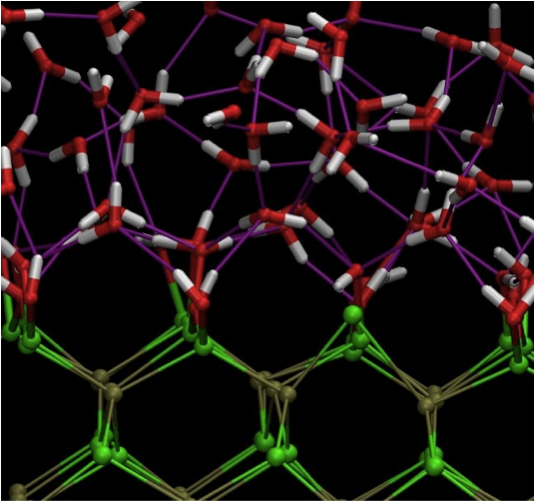Brandon Wood, Tadashi Ogitsu, Tuan Anh Pham
Photo-electrochemical hydrogen production uses sunlight and water to generate chemical fuel, and as such promises a truly sustainable, carbon-free approach to securing U.S. energy independence. However, despite extensive laboratory efforts, no photo-electrochemical electrode material has managed to simultaneously achieve the DOE goals for efficiency and durability. For instance, III-V semiconductors can exhibit acceptably high operating efficiency, but only at the expense of shortened device lifetime.
We have been performing large-scale ab initio molecular dynamics simulations of model water-semiconductor interfaces in order to obtain a detailed, fundamental understanding of the microscopic mechanisms involved in photocatalytic water splitting. Such understanding is crucial for engineering water-splitting catalysts that are both efficient and corrosion resistant, thereby facilitating successful commercialization of photoelectrochemical devices. Our approach uses realistic models that account for the full interfacial chemistry and incorporate the latest algorithmic developments, allowing us to investigate the vital link between the interfacial kinetics and the surface reactions that drive photocatalysis and corrosion. We also simulate X-ray absorption and emission spectra, which are compared to experiments for further insight.

Figure: Water at the interface with a hydroxylated InP(001) photoelectrochemical electrode.
[1] B.C. Wood, E. Schwegler, W.I. Choi, and T. Ogitsu, “Hydrogen-bond dynamics of water at the interface with InP/GaP(001) and the implications for photoelectrochemistry,” J. Am. Chem. Soc. 135, 15774 (2013).
[2] B.C. Wood, E. Schwegler, W.I. Choi, and T. Ogitsu, “Surface chemistry of GaP(001) and InP(001) in contact with water,” J. Phys. Chem. C 118, 1062 (2014).
[3] B.C. Wood, T. Ogitsu, and E. Schwegler, "Local structural models of complex oxygen- and hydroxyl-rich GaP/InP(001) surfaces," J. Chem. Phys. 136, 064705 (2012).
[4] B.C. Wood, T. Ogitsu, and E. Schwegler, "Ab initio modeling of water-semiconductor interfaces for photocatalytic water splitting: The role of surface oxygen and hydroxyl," Journal of Photonics for Energy 1, 016002 (2011).
